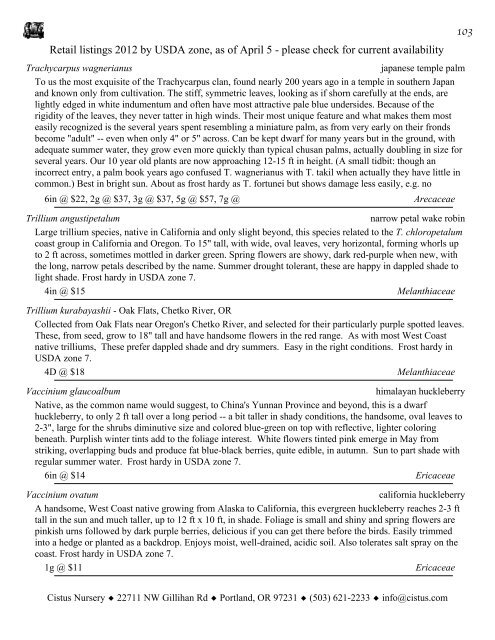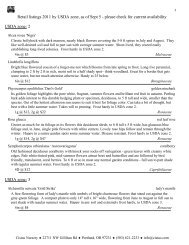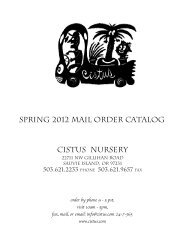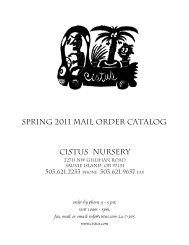1 Retail listings 2012 by USDA zone, as of April 5 ... - Cistus Nursery
1 Retail listings 2012 by USDA zone, as of April 5 ... - Cistus Nursery
1 Retail listings 2012 by USDA zone, as of April 5 ... - Cistus Nursery
Create successful ePaper yourself
Turn your PDF publications into a flip-book with our unique Google optimized e-Paper software.
<strong>Retail</strong> <strong>listings</strong> <strong>2012</strong> <strong>by</strong> <strong>USDA</strong> <strong>zone</strong>, <strong>as</strong> <strong>of</strong> <strong>April</strong> 5 - ple<strong>as</strong>e check for current availability<br />
Trachycarpus wagnerianus japanese temple palm<br />
To us the most exquisite <strong>of</strong> the Trachycarpus clan, found nearly 200 years ago in a temple in southern Japan<br />
and known only from cultivation. The stiff, symmetric leaves, looking <strong>as</strong> if shorn carefully at the ends, are<br />
lightly edged in white indumentum and <strong>of</strong>ten have most attractive pale blue undersides. Because <strong>of</strong> the<br />
rigidity <strong>of</strong> the leaves, they never tatter in high winds. Their most unique feature and what makes them most<br />
e<strong>as</strong>ily recognized is the several years spent resembling a miniature palm, <strong>as</strong> from very early on their fronds<br />
become "adult" -- even when only 4" or 5" across. Can be kept dwarf for many years but in the ground, with<br />
adequate summer water, they grow even more quickly than typical chusan palms, actually doubling in size for<br />
several years. Our 10 year old plants are now approaching 12-15 ft in height. (A small tidbit: though an<br />
incorrect entry, a palm book years ago confused T. wagnerianus with T. takil when actually they have little in<br />
common.) Best in bright sun. About <strong>as</strong> frost hardy <strong>as</strong> T. fortunei but shows damage less e<strong>as</strong>ily, e.g. no<br />
tattering. Our seed is produced from our own isolated plants. Woohoo! These plants already at le<strong>as</strong>t 4 years<br />
6in @ $22, 2g @ $37, 3g @ $37, 5g @ $57, 7g @ Arecaceae<br />
Trillium angustipetalum narrow petal wake robin<br />
Large trillium species, native in California and only slight beyond, this species related to the T. chloropetalum<br />
co<strong>as</strong>t group in California and Oregon. To 15" tall, with wide, oval leaves, very horizontal, forming whorls up<br />
to 2 ft across, sometimes mottled in darker green. Spring flowers are showy, dark red-purple when new, with<br />
the long, narrow petals described <strong>by</strong> the name. Summer drought tolerant, these are happy in dappled shade to<br />
light shade. Frost hardy in <strong>USDA</strong> <strong>zone</strong> 7.<br />
4in @ $15 Melanthiaceae<br />
Trillium kurabay<strong>as</strong>hii - Oak Flats, Chetko River, OR<br />
Collected from Oak Flats near Oregon's Chetko River, and selected for their particularly purple spotted leaves.<br />
These, from seed, grow to 18" tall and have handsome flowers in the red range. As with most West Co<strong>as</strong>t<br />
native trilliums, These prefer dappled shade and dry summers. E<strong>as</strong>y in the right conditions. Frost hardy in<br />
<strong>USDA</strong> <strong>zone</strong> 7.<br />
4D @ $18 Melanthiaceae<br />
Vaccinium glaucoalbum himalayan huckleberry<br />
Native, <strong>as</strong> the common name would suggest, to China's Yunnan Province and beyond, this is a dwarf<br />
huckleberry, to only 2 ft tall over a long period -- a bit taller in shady conditions, the handsome, oval leaves to<br />
2-3", large for the shrubs diminutive size and colored blue-green on top with reflective, lighter coloring<br />
beneath. Purplish winter tints add to the foliage interest. White flowers tinted pink emerge in May from<br />
striking, overlapping buds and produce fat blue-black berries, quite edible, in autumn. Sun to part shade with<br />
regular summer water. Frost hardy in <strong>USDA</strong> <strong>zone</strong> 7.<br />
6in @ $14 Ericaceae<br />
Vaccinium ovatum california huckleberry<br />
A handsome, West Co<strong>as</strong>t native growing from Al<strong>as</strong>ka to California, this evergreen huckleberry reaches 2-3 ft<br />
tall in the sun and much taller, up to 12 ft x 10 ft, in shade. Foliage is small and shiny and spring flowers are<br />
pinkish urns followed <strong>by</strong> dark purple berries, delicious if you can get there before the birds. E<strong>as</strong>ily trimmed<br />
into a hedge or planted <strong>as</strong> a backdrop. Enjoys moist, well-drained, acidic soil. Also tolerates salt spray on the<br />
co<strong>as</strong>t. Frost hardy in <strong>USDA</strong> <strong>zone</strong> 7.<br />
1g @ $11 Ericaceae<br />
<strong>Cistus</strong> <strong>Nursery</strong> ◆ 22711 NW Gillihan Rd ◆ Portland, OR 97231 ◆ (503) 621-2233 ◆ info@cistus.com<br />
103







